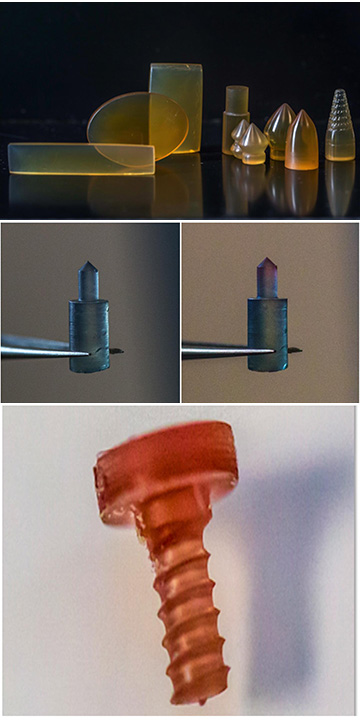
The Tufts team’s fabrication process could create macroscopic silk-based objects of varying sizes and shapes (top). Among the functionalities the team demonstrated were a surgical pin that changed color as it approached its yield stress limit (middle), and a screw with embedded gold nanorods that could be plasmonically heated with the application of diffuse infrared LED light (bottom). [Images: Silklab, Department of Biomedical Engineering, School of Engineering, Tufts University]
In recent years, natural silk has attracted increasing attention for its potential as a tough, biologically friendly medium for fashioning nano- to microscale optical devices (see “Silk: A different kind of ‘fiber optics,’” OPN, June 2014). Now, engineers at Tufts University, USA, led by OSA Fellow Fiorenzo Omenetto, have taken another step on the silk road: they’ve created a process for building macroscopic, bulk materials from silk that can embed interesting functionalities—including optically enabled ones (Proc. Natl. Acad. Sci., doi: 10.1073/pnas.1612063114).
Among the proof-of-concept devices demonstrated by the team are silk-based surgical pins that can signal strain through a color change, and a silk-built structural screw that can be plasomonically heated by applying infrared light. The team suggests that the new process for creating such macroscopic, functional forms from silk represents “a step toward the development of multifunctional devices that may liaise between the biotic and abiotic worlds.”
Leveraging protein self-assembly
As with the Tufts group’s previous work with micro- and nanoscale silk materials, the more recent macro-scale work involves a basic understanding of the bottom-up nature of silk protein self-assembly, and “co-opt[ing] the bottom-up generative process to engineer function directly within end-material formats.” Specifically, the team developed a water-based process for extracting natural proteins from the silk of the common silkworm, Bombyx mori, to create silk fibroin hydrogels with different micro- or nanoscale properties that could be aggregated into larger solids.
The engineers then used a variety of techniques, including cryogenic transmission electron microscopy, micro-Raman spectroscopy, differential scanning calorimetry, and a number of mechanical tests, to suss out the detailed properties of the different silk gels at various stages during the protein self-assembly process. Those detailed data gave the team clues about when and how to embed additional materials and functional elements into the matrix from the top down, while the protein hydrogels are assembling, to add functionality to the resulting macroscale solid object.
Optically enabled bio-inspired materials
In one example, the engineers embedded gold nanorods, approximately 20 nm in length and a few nm in width, into the silk fibroin liquid suspension, and then molded it into a solid silk fibroin screw through quasistatic evaporation of water from the material. The resulting screw with the embedded nanorods—owing to the latter items’ ability to enhance the light field through subwavelength, surface-plasmon effects—could be heated to a temperature as high as 160 ºC when exposed to diffuse, 850-nm infrared light from an LED.
As another demonstration, the Tufts team impregnated the growing silk polymer gel with microscopic polydiacetylene (PDA) vesicles, the color of which changes from blue to red with strain owing to conformational changes in the PDA protein. They then solidified the material and machined it into a form reminiscent of a surgical pin, the color of which changes from blue to red as the bulk material approaches failure.
The researchers believe that the new processes could ultimately be spun into a wide range of applications. These could include, according to the group, things such as mechanical components for orthopedics embedded with growth factors or enzymes that can be delivered at the point of injury; surgical screws that change color as they reach their torque limits; and structural nuts and bolts that can sense and report on the environmental conditions of their surroundings. The approach, the team concludes, “underscores the opportunity provided by the combination of bottom-up and top-down fabrication approaches to empower bioinspired fabrication methods for compelling and high-performing multifunctional materials.”
